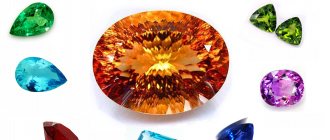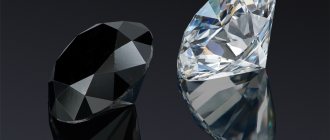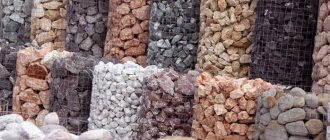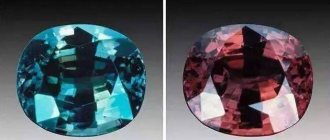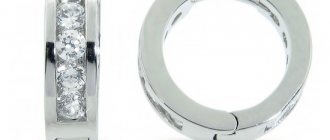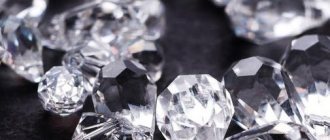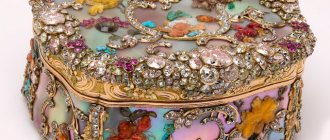The concept of a precious stone: features of terminology
Today there is no single concept of a precious stone. At the same time, such gems include minerals that meet certain criteria. The following are considered the key properties of precious stones:
- good appearance;
- uniqueness;
- high strength.
When assessing the appearance, shimmer, shine, and play of light are taken into account. Experts also take into account optical characteristics such as pleochroism and dispersion.
Finding minerals in nature is very difficult. This is due to their small number. Due to this, gems are considered unique and are in great demand. The durability of stones is associated with strength, density and hardness. These parameters influence the formation of the price of the gem.
As for legal aspects, according to the laws of the Russian Federation, the list of precious stones includes diamonds, alexandrites, and sapphires. It also contains emeralds and rubies. Natural sea pearls also belong to this group.
The exact evaluation criteria for specific parameters are not fixed. At the same time, there are a number of classifications of precious minerals. Therefore, each country independently chooses an assessment method and performs a breakdown into categories.
To know everything about precious stones, you need to familiarize yourself with their key characteristics. One of the important selection criteria is the transparency indicator. This is a very important characteristic that largely affects the price of the mineral. Gemologists define transparency as the ability of a material to transmit light through it.
This property is determined by the structure of the crystal and the presence of defects or inclusions in its composition that distort the light flux. The level of transparency can be assessed using a special device - a spectrophotometer.
Taking into account the degree of transparency, the following types of minerals are distinguished:
- Completely transparent - these can be colorless or slightly colored gems. Objects are clearly visible through them without obvious changes.
- Half transparent - this category includes colored and colorless stones. Through them, objects appear distorted or blurry.
- Minerals that transmit light in thin layers - the flow can only overcome the surface layer. At the same time, nothing can be seen through the entire stone.
- Opaque - do not allow light to pass through at all.
Another important criterion that affects the cost of a mineral is gloss. This term refers to the ability of a gem to refract or reflect light. There are several types of glitter:
- Diamond – characterized by pronounced reflection of light from the surface. This type of shine is, in particular, characteristic of zircon and diamond.
- Glass - resembles glass in terms of light reflection. This parameter characterizes corundum.
- Waxy - it is characterized by a slight gloss against a matte surface. This type of shine is inherent in jasper and turquoise.
- Resinous - considered amber.
- Mother-of-pearl - pearls and opal have it.
An important parameter when assessing the quality of minerals is the degree of hardness. This value of gemstones is assessed using the Mohs scale. In this case, points are given from 1 to 10. Certain minerals are used as standards.
Diamonds with a hardness level of 10 are considered the undisputed leaders. In second place are corundums, the hardness of which is awarded 9 points. Topazes have a parameter of 8 points. Then the following minerals are arranged in descending order:
- quartz – 7 points;
- opal – 6 points;
- apatite – 5 points;
- fluorite – 4 points;
- calcite – 3 points;
- gypsum – 2 points;
- talc – 1 point.
The location of the remaining minerals is determined by their ability to damage each other's surfaces. If the material being examined scratches the standard, it has a higher hardness parameter.
Important! The harder the gem, the higher its density and the ability to maintain its cut for a long time. Such minerals do not wear off for a long period of time and look like new.
When choosing a mineral, you should also consider its color. At the same time, an ordinary buyer will not be able to choose a high-quality gem using this criterion. Even minerals of the same type can differ significantly in shades depending on the presence of impurities in the composition.
Determining the type of mineral can only be determined by a qualified gemologist, who, using special crystallographic methods, will be able to understand what type of jewelry it is. In this case, gems can be purple, white, pink. There are red, green, yellow pebbles. Black and blue minerals look impressive.
Therapeutic effect
Datolite is a stone of psycho-emotional balance. It helps to recover from stressful situations, get rid of nervous tension and insomnia, excessive anxiety and panic, and get out of a depressive state.
Among other medicinal properties, it should be noted the positive effect of datolite on the condition of the skin, the genitourinary system in women, metabolism and metabolism.
Gems
A gemstone is a mineral characterized by excellent transparency and a high degree of hardness. These gems can retain their appearance and color for a long time. What stones are considered precious? This category includes a variety of gems - sapphire, emerald, alexandrite, chrysoberyl, ruby.
Diamonds top this list of these minerals. Also, emeralds, rubies, and blue sapphires may also belong to the first order of the first group.
Diamonds surpass all other minerals in value. The Encyclopedia of Stones says that they are obtained by processing diamonds, which can be the hardest mineral elements. According to the Mohs scale, they have a maximum strength of 10 points.
Diamonds are 10 times harder than sapphires, which have a hardness rating of 9. It is believed that the mineral is called this way because of the Greek term “adamas”, which translates as “indestructible”. There is also another version of the name of the diamond, which believes that it comes from the Persian word “elma”. Translated, this means “hardest”.
Emeralds are a green-colored variety of beryl. This beautiful mineral is characterized by amazing transparency. Its color is associated with the presence of chromium or vanadium in the composition. Beryls are not considered very hard, but have a high value. The highest quality is considered to be dark green Colombian beryl, the crystals of which include vanadium.
Rubies have a rich red hue. According to their chemical structure, these natural stones belong to the corundum group. In Latin, the word "rubeus" means "red". Red rubies with a purple tint have the maximum value. This gemstone color is also called pigeon blood shade.
Rare mineral structures include rubies, which contain the element rutile. Such products are characterized by a special asterism effect.
Sapphires are precious stones that are characterized by amazing transparency. The mineral gets its blue color due to the presence of iron and titanium in the structure. Taking into account the predominance of one or another component, the shade of sapphires also changes. It can be pale blue or dark blue. Ultramarine sapphires look spectacular.
Place of Birth
Datolite crystals from San Luis Potosi, Mexico
Datolites are of hydrothermal origin. They are not found in pure form, but are formed in proximity to other minerals or solidified magma.
Deposits where datolite is mined on an industrial scale are located in Germany, France, Great Britain, Crimea, Tien Shan, Norway, USA, Japan, Italy, Primorsky Krai, the North Caucasus and Siberia in Russia.
Collection quality mineral deposits are being developed in Azerbaijan, Kazakhstan, Transcarpathia of Ukraine, the Czech Republic, the Eastern Pamirs and the Far East.
Semiprecious stones
The list of semi-precious stones includes jewelry that is used for decorations and applied crafts. The following criteria indicate the high quality of semi-precious stones:
- transparency;
- bright and clean color;
- absence of cracks and foreign inclusions;
- attractive pattern;
- mineral size.
In the modern jewelry industry, about a hundred types of such minerals are used. The value of all stones depends on the following factors:
- rare in nature;
- decorative and artistic characteristics;
- fashion trends;
- strength, which affects the durability parameters of gems.
Today, it is not recommended to call jewelry stones semiprecious. This term is considered obsolete by gemologists. However, it is often used in trade and is even recorded in legal papers.
At first, semi-precious stones were called stones that, according to some criteria, did not meet precious ones. They could be inferior in appearance, strength and, as a result, price.
Today such a term is considered incorrect. The fact is that the prefix “semi-” seems to discredit the jewelry in the eyes of buyers, hinting at its inferiority and cheap price.
Precious and semi-precious minerals may have different values, and the latter may command a higher price than the former. Therefore, today such products are recommended to be called jewelry stones.
In accordance with the classification of E.Ya. Kievlenko, the second order of the first group includes sapphires of unusual colors, alexandrites, black opals and jadeites. Alexandrite is a chrysoberyl that can change color depending on the light. In natural light it appears green, and in artificial light it appears red-violet. This characteristic is associated with the presence of trivalent chromium particles in the composition.
Opals are silica hydrogels. This means that they are amorphous quartz, the structure of which contains up to 10% water. The noble black opal has the maximum value. Its surface is decorated with rainbow tints. As a rule, opals are not cut. They are shaped into cabochons.
White and fire opals belong to the third order. Also included in this category are aquamarines. Spinel and chrysolite belong to this group. In addition, this category includes red tourmaline rubellite and other stones and minerals.
Topaz also belongs to this group. It is an aluminum silicate containing fluorine. Topazes can have yellow, golden, pink shades. Minerals that have pronounced opalescence look beautiful. The stones have a bright shine and can easily withstand various types of processing, including grinding. According to the Mohs scale, their hardness is 8 points.
Order IV includes different types of tourmaline. It can be polychrome or pink. Blue and green species belong to this category. Also in the group of minerals belonging to this order are natural stones such as garnet, orange zircon, citrine, and amethyst.
Today there are many varieties of jewelry and ornamental minerals. Below are the stones in alphabetical order:
- beryl – this category includes morganite, chrysoberyl, aquamarine;
- garnets - there are such types as tsavorite, pyrope, rhodolite, demantoid;
- quartz – the group includes citrine, rauchtopaz, amethyst, prasiolite;
- opal;
- taaffeit;
- tanzanite;
- topaz;
- tourmaline - these include verdelite, paraiba, indigolite;
- chrysolite - such stones include olivine and peridot;
- zircon;
- spinel;
- euclase
Magic properties
Datolite is a generator of positivity and generosity. The stone develops positive character traits of its owner, but does so gradually.
It is believed that its properties will fully manifest themselves after prolonged constant contact with minerals. Anyone who carries datolite with him for 2 years will receive respect and public recognition.
Therefore, it is recommended for politicians, managers and people involved in big business to have a talisman with this stone.
Datolite also influences the spiritual nature of its owner. After contact with the mineral, he will find harmony and unity with nature, learn to appreciate life and loved ones nearby.
Datolite in astrology
Not all zodiac signs can wear the mineral.
The favorites of datolite are the zodiac signs belonging to the elements of Fire and Earth. Contact with the stone will have a positive impact on their character, protect them from unpious acts, and develop traits such as generosity and magnanimity.
The gem will not refuse to help representatives of the Air element. Datolite will show its magical properties in relation to them, but this will take a little time. For approximately a month, you should talk to the stone every day, tell it about your affairs and needs.
Those born under the signs of Cancer, Scorpio and Pisces should not use datolite. Representatives of the Water element will not be able to find mutual understanding with the stone, which will negatively affect their emotional state.
How to distinguish from a fake
Datolite mineral
Under the guise of datolite, the buyer is often offered cheap plastic or glass. You can distinguish a real stone from a cheap fake by the main feature - the shape of the crystals. Also, real datolite is painted in soft natural colors.
A standard feature of the difference between natural stone and plastic and glass is the determination of its weight and thermal conductivity. Real datolite is cool to the touch, and when placed in the palm of your hand, you can feel a pleasant heaviness.
